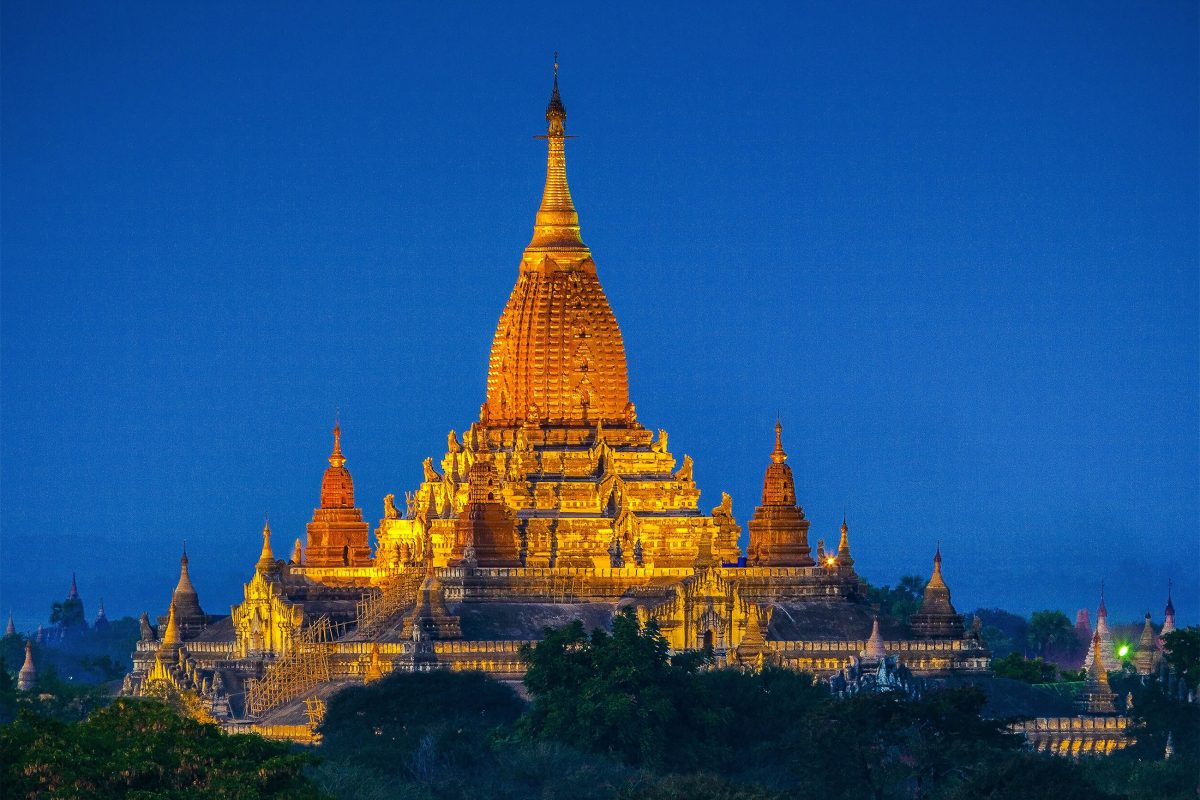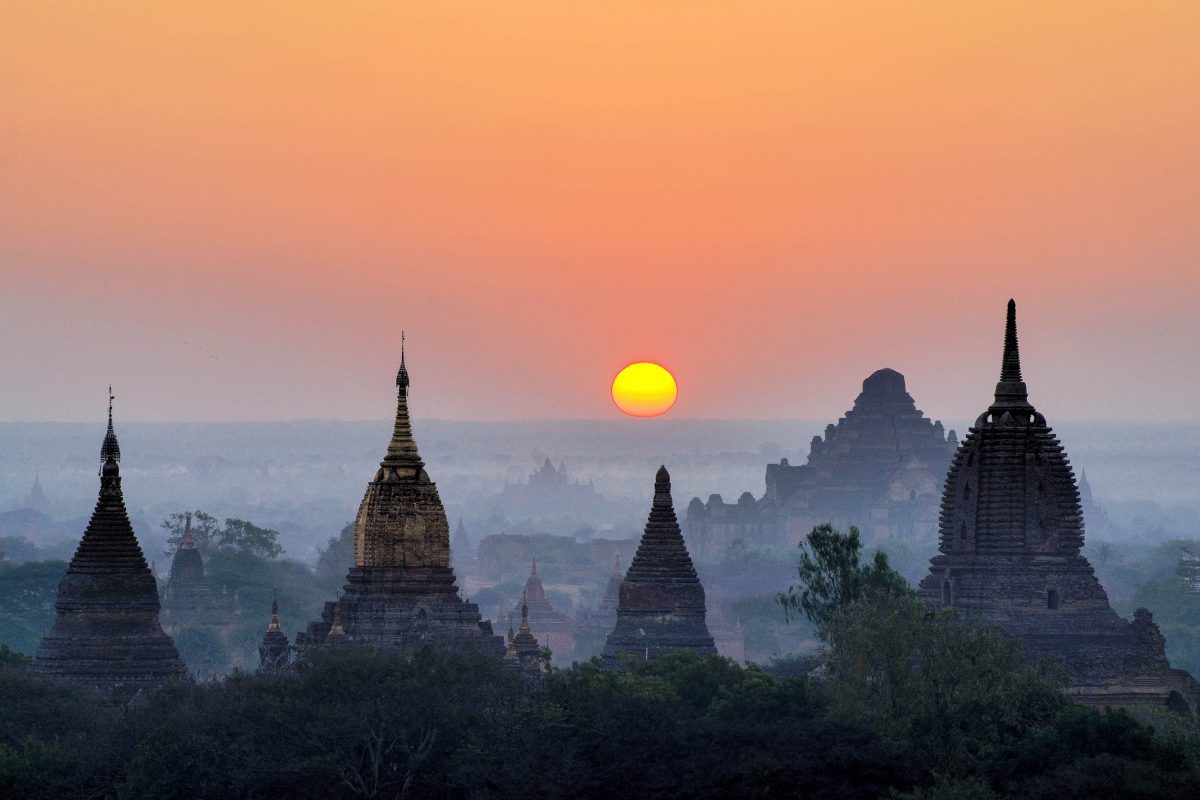In der historischen Königsstadt Bagan im Zentrum von Myanmar stehen heute noch an die 2.000 prächtige Stupas, Tempel und Pagoden. Auf einer Fläche von 30 Quadratkilometern stellen sie eine der größten Ausgrabungsstätte Südostasiens dar.
Die historische Stadt Bagan liegt im Zentrum von Myanmar etwa 150km südwestlich der Stadt Mandalay am Ufer des Flusses Irrawaddy. Bagan war einst Hauptstadt des Königreichs Pagan, welches sich beinahe über ganz Myanmar erstreckte. Bis heute sind in Bagan an die 2.000 Ziegelsteinbauten erhalten.
Die Tempelstadt hält damit mehrere Rekorde: Sie ist die weltweit größte Ansammlung an buddhistischen Tempeln, Stupas und Pagoden. Die Region der historischen Sakralbauten umfasst eine Fläche von über 30 Quadratkilometern, was sie zur größten Ausgrabungsstätte Myanmars und eine der größten in ganz Südostasien macht.
Inhaltsverzeichnis
BILDER: Tempelstadt Bagan
Fotogalerie: Tempelstadt Bagan
Anreise nach Bagan – am besten aus der Luft
Am besten nimmt man von Yangon aus das Flugzeug nach Bagan, denn die Anreise nach Bagan ohne zu fliegen ist relativ aufwändig. Durch die abgeschiedene Lage dauert es mit dem Auto von Mandalay aus etwa 9 Stunden, mit dem Zug und mit dem Boot auf dem Irrawaddy etwa 7 Stunden.
Die Tempelanlage von Bagan kann am besten mit dem Mietauto oder mit dem Fahrrad erkundet werden. Auch Pferdekutschen sind verfügbar. Das gewaltige Ausmaß des gesamten Pagodenfelsens lässt sich am besten erfassen, indem man die Spitze eines der gut erhaltenen Ziegelbauten erklimmt oder eine fantastische Runde mit dem vor Ort angebotenen Heißluftballon dreht.
Anders ist es unmöglich, alle 2.000 Bauten zu sehen – man muss schon froh sein, wenn man an einem Tag die 20 eindrucksvollsten Pagoden schafft, besser daher mindestens zwei Tage für Bagan einplanen. Bei Sonnenauf- oder Sonnenuntergang ist die Stimmung übrigens am eindrucksvollsten.
Tipp: Auch in der 5 Kilometer entfernten Stadt Neu-Bagan gibt es zahlreiche Unterkunftsmöglichkeiten, die etwas preisgünstiger sind – dafür natürlich auch nicht das Flair von „Alt-Bagan“ mit sich bringen.
Sehenswürdigkeiten von Bagan

Bewegt man sich durch die imposanten historischen Bauten erhält man eine Vorstellung von der einstigen Pracht der Stadt. Die Tempel können sowohl von außen als auch von innen besichtigt werden.
Tipp: Bei einem Besuch in Bagan unbedingt ausreichend Sonnenschutz, Wasser und eine Kopfbedeckung mitnehmen. In Bagan ist nichts klimatisiert und Schatten vor der glühenden Mittagssonne gibt es so gut wie keinen. Außerdem sind Schuhe ohne Socken zu empfehlen, die bequem aus- und rasch wieder angezogen werden können, da die meisten Tempel nur barfuß betreten werden dürfen. Allerdings sollten sie für Kletterpartien auf den Tempeln auch nicht zu fragil sein.
Die Ausrichtung der Tempel im Sinne des Universums ist auch heute noch zu sehen. Ein Teil des Quadrates wurde jedoch durch den Irrawaddy ausgewaschen, wodurch das Gelände heute eher dreieckig ist. Im für Buddha Gautama reservierten Zentrum errichtete König Anawrahta seinen Palast und den Mahabodhi Tempel.
Hot Spots für den Sonnenuntergang
Die vergoldete kürbisförmige Bupaya-Pagode liegt hoch über dem Fluss Ayeyarwady und wurde während des Erdbebens völlig zerstört. Mittlerweile strahlt sie wieder in altem Glanz und ist ein beliebter Treffpunkt für Touristen, um den Sonnenuntergang zu genießen.
Auch die prachtvolle goldene Shwezigon Pagode in Nyaung U, DER Protoyp einer birmischen Pagode und eines der wichtigsten Heiligtümer des Landes, ist im roten Sonnenlicht eine Augenweide.
Ananda – der heiligste Tempel Bagans

Im Ananda-Tempel, dem heiligsten Tempel Bagans, benannt nach dem Cousin und langjährigen Begleiter Buddhas, befinden sich vier 12m hohe Buddhastatuen, die in alle vier Himmelsrichtungen blicken. Hier findet jährlich im Dezember oder Jänner ein einwöchiges Fest statt, im Zuge dessen tausende Gläubige den Mönchen am Morgen des Vollmondtages Opfer bringen. Rund um den Tempel werden Zelte und Hütten errichtet, die Bagan für kurze Zeit in einen fröhlichen Jahrmarkt verwandeln.
Buddhas wohin das Auge blickt
Der knapp 50m hohe an Htilominlo-Tempel beherbergt im ersten Stock ebenfalls je eine Buddhastatue für jede Himmelsrichtung. Das terrassenförmige Dach wird von einem goldenem Hti (wörtlich „Schirm“) abgeschlossen. Als Vorbild für den Htilominlo-Tempel galt der Sulamani-Tempel, der vor allem durch seine Wandmalereien und die erstaunlich gut erhaltenen Fassaden-Dekorationen aus Stuck und Kacheln beeindruckt. Auch hier gibt es für jede Himmelsrichtung eine Buddha-Statue.
Der Htilominlo-Tempel wird noch vom 61m hohen Thatbinnyu-Tempel übertroffen, der das höchste Gebäude in Bagan darstellt.
Dhamma Yangyi-Tempel – von Geistern bewohnt?

Um den Dhamma Yangyi-Tempel ranken sich zahlreiche Mythen und Legenden, viele behaupten sogar, dass es innerhalb seiner meisterhaft zusammengefügten Mauern spukt.
Dies liegt daran, dass sein Erbauer, König Narathu, den Tempel errichten ließ, um sich vom Mord an seinem Vater, seinem Bruder und seiner Ehefrau reinzuwaschen. Er war generell für seine Grausamkeit bekannt.
So bezahlte zum Beispiel auf den Tempel-Baustellen ein Maurer, der die Steine nicht exakt aufeinander fügte, diesen Faux-pas mit seinem Leben. Deshalb sind die Ziegel heute noch so aufeinander geschichtet, dass nicht einmal eine Nadel dazwischen Platz hat.
Innere Werte der Bagan-Tempel
Nicht nur die Gebäude selbst, auch die kostbaren Wandmalereien stellen unvergleichliche Schätze dar. Sie stammen aus dem 11. bis 13. Jahrhundert, sind aufgrund des trockenen Klimas äußerst gut erhalten und zählen zu den ältesten Gemälden in ganz Südostasien. Vor allem die fantastischen Malereien im Adebayana-Tempel sind hier hervorzuheben.
Die Renovierungsarbeiten in Bagan an den Gebäuden, Malereien und Inschriften sind seit den 1950er Jahren im Gange. 1975 wurde durch ein starkes Erdbeben noch vieles zerstört, was nun von den Archäologen wieder rekonstruiert und aufgebaut wird. Seit der Ernennung von Bagan als Weltkulturerbe übt auch die UNESCO Druck auf die Verantwortlichen für die Erhaltung der Gebäude aus.
Geschichte von Bagan
Die Tempelbauten in Bagan wurden bereits im ersten Jahrtausend nach Christus errichtet. Am Ufer des Irrawaddy trafen sich einst die Handelswege aus China und Indien. Die Stadtmauer, die Bagan umgab, konnte auf das Jahr 849 zurückdatiert werden. Schon damals hielten der Tantrismus und Buddhimus aus Indien Einzug in Bagan und vermischten sich mit dem dort praktizierten Schlangenkult.

Die wahre Blütezeit Bagans begann jedoch mit König Anawrahtas im Jahr 1044, der auch die Schlangen-Priester zugunsten des Tharavada-Buddhismus aus der Stadt vertrieb. Anawrahtas und sein Sohn nutzten Religion und Politik für sich und holten die Elite der Mon-Priester nach Bagan, was zur Übernahme der literarischen Mon-Kultur und ihrer Schrift führte.
Bagan entwickelte sich immer weiter und war im Mittelalter mit 40 Quadratkilometern 15mal größer als das damalige London. Da es keine kriegerischen Auseinandersetzungen gab, hatte die Bevölkerung Zeit und Geld für Architektur und die aufwendig gearbeiteten Pagoden schossen im 11. und 12. Jahrhundert geradezu aus dem Boden. Insgesamt sollen es 6.000 gewesen sein.
Bagan als Abbild des Universums

Die Tempelanlagen bildeten dabei das Universum nach dem buddhistischen Glauben ab. Auf einem perfekten Quadrat befand sich im Zentrum der Götterberg Meru, während die Felder um ihn herum die damals bekannten acht Planeten darstellten. Die Weitläufigkeit des Areals liegt daran, dass früher zwischen den Steinbauten auch die Wohnhäuser der Bevölkerung standen. Diese waren allerdings aus Holz und Bambus und überdauerten die Zeit nicht.
Die Prachtbauten, die Bagan heute seinen weltweiten Ruhm einbringen, wurden der Stadt vor knapp tausend Jahren zum Verhängnis. Der Bau der Tempel und Pagoden verschlang Unsummen, noch dazu waren Tempel und Klöster steuerfrei und auch die Gouverneure der eroberten Provinzen zahlten ihre Anteile bald nicht mehr.
Schließlich wurde Bagan Ende des 13. Jahrhunderts vom Mongolenherrscher Kublai Khan erobert. Vor seiner Flucht hatte König Narathihapate noch viele der Pagoden abreißen lassen, um eine stärkere Stadtmauern zu bauen – vergeblich. Bagan fiel und mit seiner Hauptstadt zerfiel das ganze Pagan-Reich in kleine Staaten, die sich jahrhundertelang gegenseitig bekämpften.
Weiterführende Links:





